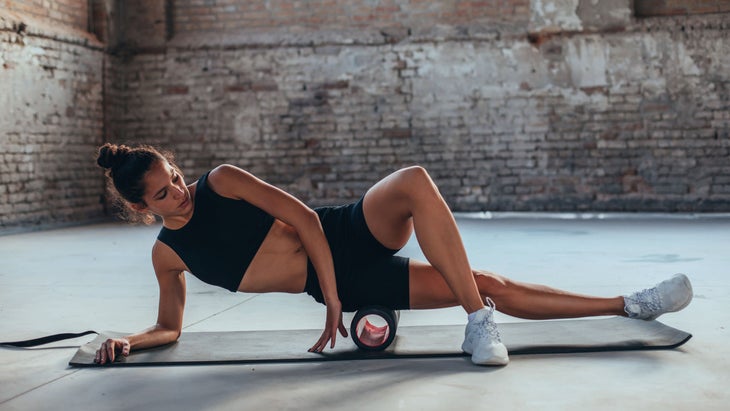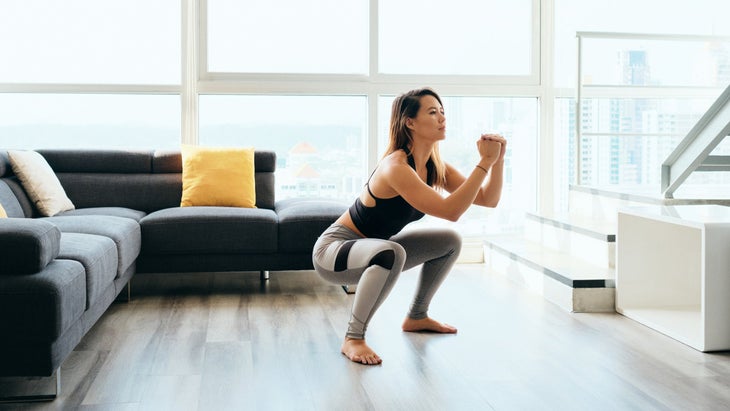In October 2011, months after a seventh-place finish at the IAAF World Championships, two-time U.S. 5K champion Lauren Fleshman was training for the New York Marathon when she felt a twinge of pain in her knee. Fleshman figured she could dial back her training for a few weeks and wait for the pain to subside. “I didn’t want to take any real time off, though,” she says. “I ended up racing the marathon on it and really screwed it up.”
Fleshman was feeling the familiar torment of IT band syndrome, a sharp outer-knee pain that afflicts everyone from once-a-year charity 5K runners to world-class marathoners. She spent the next ten months after New York nursing the ligament in preparation for running the 2012 Olympic Trials. “If the IT band hurts, you’ve got to take it seriously,” Fleshman says.
But not every runner has access to Olympic-caliber doctors. So we talked to Fleshman and other experts to give you the best advice we can about this common but totally preventable running injury.
What Is IT Band Syndrome?
The iliotibial band, as it’s formally called, is a fascia—or fibrous tissue that connects, stabilizes, and protects muscles and internal organs. It runs from the outside of the pelvis to the lower knee and inserts into the top of the shinbone.
This do-it-all band acts as a hip abductor (helping with movement away from the body), assists with hip adduction (movement toward the body), and stabilizes the knee while running. Unlike a muscle, the IT band is not particularly malleable—it’s more like a leather belt than a rubber band—and it’s packed with nerves, which explains the intense pain of lying sideways on a foam roller.
When the IT band becomes tight or inflamed, it creates friction as it rubs against the outer portion of your upper tibia, which causes pain on the outside of the knee. This is different than pain on the front of the knee, which could be patellofemoral pain syndrome, commonly know as runner’s knee, and is most commonly caused by overuse. “Think of the IT band as a violin string rubbing along the side of your knee,” says Dr. Jordan Metzl, sports medicine doctor and author of . “If that string is stretched too tightly, it starts to get irritated over time, and that’s when you get IT band syndrome.”
What Causes IT Band Pain?
While IT band syndrome is often classified as an overuse injury, a variety of individual elements can irritate the temperamental tissue, says Mike Maciejewski, an athletic trainer at the University of Michigan’s program. These can include leg-length discrepancies, excessive pronation, muscle weakness in the glutes and hips, hamstring weakness, and a host of other strength deficiencies. Runners training for a marathon are especially susceptible to the injury, Metzl says. This is most likely due to the combination of high mileage and unvaried pace.
That’s what happened to Fleshman, who hypothesizes that her IT band issues were a combination of running on slushy, uneven winter road conditions in Eugene, Oregon, and the repetitive cadence and increased mileage of ramping up marathon training. “For 5K training, you do tempos, faster intervals, speed work, and dynamic strengthening in the gym. You go through different knee and hip angles,” she says.
How Do I Know If I Have IT Band Pain?
Initially, runners may not feel pain until they’re miles into their workout. This factor differentiates IT band syndrome from another common knee injury—a lateral meniscus tear—which will hurt immediately.
“IT band syndrome tends to get gradually worse if you don’t fix what’s happening,” Metzl says. The pain will be specific to the outside of the knee and may induce sharp pain and a grinding sensation as the tissue fails to adequately insulate muscle from bone. The injured leg will likely feel tighter and more restricted than the opposite leg, and the pain will happen progressively earlier in the run as the IT band continues to tighten and inflame.
While the pain may go away with self-care and rest, that may not be enough—it can persist for weeks and even months. And you may notice symptoms outside of your workouts. Maciejewski says patients often report pain while lying in bed on the affected leg and while crossing their legs. Morning knee stiffness is common. Because the band is stretched most while the leg is bent, sitting may be equally painful and can actually exacerbate the injury.
If the pain doesn’t go away shortly after it arrives, it might be best to stay away from training. “It tends to get gradually worse if you don’t fix the reason why it’s happening,” Metzl says. “In the beginning, it may come on mile six or seven, then mile two, then you can’t run more than ten minutes.”
How Do I Cure IT Band Pain?

Training through an IT band injury can aggravate existing imbalances and cause additional injuries. Employ any number of these at-home remedies to fix your aggravated IT band, but if it still hurts after a few months, see a doctor, ideally, one who specializes in running injuries, like a sports medicine doctor, orthopedic surgeon, physical therapist, athletic trainer, or podiatrist. “The clinician needs to evaluate the entire kinetic chain in order to peel back the layers to the root of the problem,” Maciejewski says.
Foam Roller
Lay sideways on a foam roller and roll back and forth from the top of the knee to the bottom of the hip. Metzl recommends runners do this each day for two or three minutes on each side to break up the tight flesh—or for as long as you can tolerate the excruciating pain.
Deep Tissue Massage
Have a masseuse press their fingers deep into the IT band, stripping the tissue along the “gutters,” or linear indentations between tissues, and massaging the tight tissue. Maciejewski prefers this method of active release therapy because he believes it targets the specific problem areas and tends to be (slightly) less painful than foam rolling.
Lacrosse Ball Massage
If you’re unable to get a deep tissue massage, try this quick substitute: Lay sideways on your elbow like you’re doing a side plank, then cross your top leg over your bottom leg to partially support your weight. Place a lacrosse ball underneath your butt, just below the hip, and gently lower yourself onto the ball. When the muscles stop spasming—and they will—roll forward (toward your hip flexor) or backward (toward your gluteus medius) and repeat until the spasms cease.
Shorten Your Stride
When your stride is too long, you stretch the IT band beyond its healthy limit and risk injury. Metzl recommends runners maintain a cadence of 180 steps or more per minute.
Check Your Terrain
To decrease the load on your knees, run on soft and flat surfaces, like smooth dirt trails. If you must run on pavement, avoid hilly and uneven routes to lessen the pounding.
Foot Support
Excessive pronation can load the outside of the knee and strain the IT band. Switch out your shoes after 500 miles, and consider heading to a local running store or athletic trainer for a gait analysis. The pros can identify whether your current shoes are supportive enough.
Sit Less
If you hit the showers and go straight to an office job, you’re not doing your IT band any favors. Desk jockeying keeps the IT band stretched and sedentary, which may increase inflammation and pain. Fleshman swapped her chair for a standing desk to expedite the healing process.
R.I.C.E.
Use this popular treatment progression—an acronym for rest, ice, compression, and elevation—as a supplemental rehabilitation tool. Take time off running and apply an ice pack to the painful area, wrap tightly with an Ace bandage, and elevate for ten minutes. Do this two or three times each day for best results.
Take Time Off
Runners are habitually greedy about their daily endorphin rush and sense of achievement, but a few days or weeks of rest could pay massive dividends down the road. Fleshman took three weeks off after the New York Marathon to heal her disgruntled IT band but says that was “not even close to enough time.” She stayed fit with short walk/sprint intervals and swimming workouts and still made the 5K final at the 2012 Trials.
Stretch
A few key stretches can loosen up the tissue surrounding the less malleable IT band. Start with the : place your right foot behind you and to the left of your body while reaching over your head and to the right with your right hand. Chase it with the , the , and the to round out the routine.
How Do I Prevent IT Band Pain?

Strength deficiencies, especially in the glutes, are the common culprit of repeated IT band syndrome injuries. “The stronger your butt muscles are, the better your running life will be,” Metzl says.
Do these killer glute and core strengthening exercises three times a week to build a rock-solid kinetic chain and kick IT band syndrome for good.
Plyometric Jump Squats
Start with a regular body squat (back straight, weight over your heels), but explode upward into a jump and land with your knees bent, starting the next squat without hesitation. Metzl recommends four sets of 15 squats.
Single Leg Squats
Stand on one leg while holding the other leg in front of you at a 45-degree angle. Squat down as deeply as possible while still being able to come back up. If you can’t make a 90-degree angle with your plant leg, place a bench underneath you and tap it at the bottom of the squat to help you stand back up.
Glute Bridge
Lay on your back with your knees bent past 90 degrees and digging your heels into the ground. Thrust your hips upward until your torso and quads form a straight line and hold that position for two seconds while squeezing your glutes. Do two or three sets of 15.
Leg Raises
Lay on your side with your hips tucked under your stomach (as opposed to pushing your butt outward) and your legs straight. Squeeze your glutes while raising your top leg 15 times. Then cross your top leg over your bottom leg and raise your bottom leg 15 times. Finally, sit upright and raise each leg 15 times while squeezing your quad to lock out the knee. That’s one set; repeat two or three times.
Clamshells
Lay on your side as you would with leg raises, but tuck your legs into a 45-degree angle (with your knees bent 90 degrees). Squeeze your glutes and raise your top knee while touching your top foot to your bottom foot—it should look just like a clamshell. Do these 15 times on each side for two or three sets, and up the ante by slipping a rubber band around your knees to add resistance.
Planks
These are remarkably effective for maintaining upright running form and keeping a quiet core, which makes you more efficient and takes the pressure off your knee. Hold for one minute on the front and one minute on each side (hands or elbows). Start in front of a mirror to lock down perfect form.


